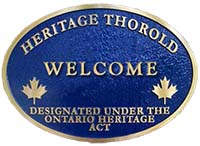Carnegie Library 1912
Thorold’s Public Library was opened in April 1912, having been made possible by a donation of $10,000.00 from Andrew Carnegie. The architect was A.E. Nicholson, who is also responsible for the Grimsby and Merriton Carnegie Libraries.
In 1902, when the grant was made, the population of Thorold was 2,400. In 1947, the interior of the library was remodelled, making it one of the most up-to-date libraries in Ontario. There were approximately 11,000 books on the shelves for a membership of 900. A music library was added with 200 record albums in circulation. Thorold’s present library was built adjacent to Chestnut Hall, opening June 18th, 1983.
Our Carnegie Library has a strong architectural presence and is a local landmark. This building is well-maintained and is a special place for our Thorold Seniors to celebrate and enjoy their time together. Reusing our heritage buildings makes them a key element of our community. There are many important names connected to Thorold’s Library system, i.e. Miss Minnie K. Tracy of the Tracy House, who was a Librarian for many years. Mr. John G. Keefer was the original Librarian, and Jacob Keefer became First Vice-President in 1858, with Rev. Thomas Brock Fuller acting as President.
Designation of this building is based on the interesting and distinctive history of Andrew Carnegie and the Carnegie Libraries in Ontario. An appearance of elegance, grace and dignity was common to all the Carnegie Library buildings, imparting a sense of pride and stability to their communities.
Born in Dunfermline, Scotland in 1835, and the son of a hand loom weaver, Andrew Carnegie rose from humble geginnings to a place where his name would be spoken with that of J.P. Morgan, Charles M. Schwab and John D. Rockefeller. His success and career in the American steel industry is legendary. The transfer of his empire to the U.S. Steel Corp. (J.P. Morgan) was, at that time, the greatest sale in history and made Andrew the richest man in the world.
In 1911, he formed the $125,000,000 Carnegie Corp. of New York. Its purpose was to promote the advancement of knowledge. During his lifetime, Andrew Carnegie gave away more than $350 million dollars. More than 2,500 public libraries were built throughout the English-speaking world in the early 1900’s at a cost of over $56 million, all funded by Andrew Carnegie.
There were 1,681 libraries built in the United States, 660 in Great Britain and Ireland, and 125 in Canada, 111 of these in Ontario. Valuing the heritage of our city is an important example to set for future generations. Our heritage gives us that special “sense of place” in a busy and confused world. Our Carnegie Library proudly stand in a place of importance and is part of the rich history of our City.
